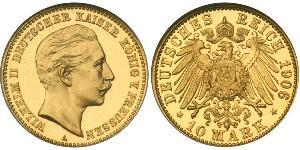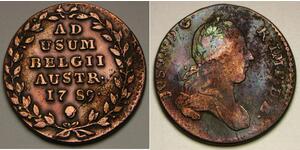4 Pfennig Kingdom of Prussia (1701-1918) Copper
GERMANY-PRUSSIA 4 Pfennig 1840 A. Jaeger 45, AKS 32.
9
coins in the group
| 1 | 2 |
|---|
(1500 X 739 pixels, file size: ~218K)
Posted by: anonymous 2019-03-24
Brandenburg-Preußen. Friedrich Wilhelm III. 1797-1840. 4 Pfennig 1821 A. Jaeger 45, AKS 32. Sehr schön +
(1500 X 748 pixels, file size: ~135K)
Posted by: anonymous 2018-03-13
Brandenburg-Preußen. Friedrich Wilhelm IV. 1840-1861. 4 Pfennig 1841 A. Jaeger 45, AKS 89. Vorzüglich
(1500 X 750 pixels, file size: ~165K)
Posted by: anonymous 2017-12-15
Brandenburg-Preußen, Friedrich Wilhelm III.Cu 4 Pfennig 1827 A. Jaeger 45, AKS 32. Prachtexemplar. Fast Stempelglanz
(1500 X 740 pixels, file size: ~175K)
Posted by: anonymous 2019-05-20
Brandenburg-Preußen. Friedrich Wilhelm III. 1797-1840. Cu 4 Pfennig 1822 B. Jaeger 45, AKS 32. Sehr schön
(900 X 450 pixels, file size: ~125K)
Posted by: anonymous 2016-12-02
Brandenburg-Preußen, Friedrich Wilhelm III. 4 Pfennig 1821 A. Jaeger 45, AKS 32. Vorzüglich
(900 X 454 pixels, file size: ~131K)
Posted by: anonymous 2017-01-04
Brandenburg-Preußen, Friedrich Wilhelm III. Cu 4 Pfennig 1839 D, Düsseldorf. Jaeger 45, AKS 32. Kleiner Randfehler, vorzüglich +
Articles
|
You may be interested in following coins
2025-05-25
- New coin is added to 2 Liard Austrian Netherlands (1713-1795) Copper
2 Liard Austrian Netherlands (1713-1795) Copper
group has 4 coins / 4 prices
⇑
AUSTRIAN NETHERLANDS 2 Liards 1789 - Copper - Joseph II. - VF+ - 1375 *
2025-05-29
- New coin is added to 1 Cent Kingdom of the Netherlands (1815 - )
1 Cent Kingdom of the Netherlands (1815 - )
group has 18 coins / 18 prices
⇑
Netherlands - 1 Cent 1862
You may be interested in ...

-500-250-pboKbzbi3QIAAAFRYVhau0KU.jpg)
-300-150-tBjZGYbcBeoAAAFpu42Zt64p.jpg)
-300-150-rGwKqUpYElIAAAFilRus7yGu.jpg)
-300-150-8IUKqUpYVjYAAAFgaxY8PlgM.jpg)
-300-150-LqN0WDeKSSsAAAFqgaiVQNM_.jpg)
-300-150-XhgKX9ISr9IAAAFYILm6674o.jpg)
-300-150-gMYKX9ISXZsAAAFZ4MO9K2rl.jpg)






-300-150-N7QKX9ISGfEAAAFX9awaL_VH.jpg)

-300-150-3mesHgTy6ZwAAAGPwuFVj7L2.jpg)






